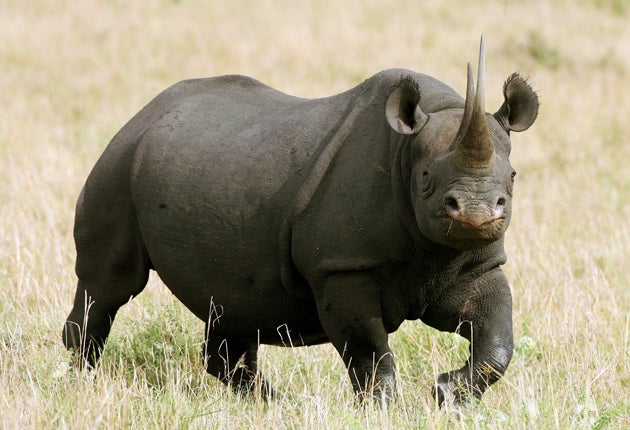The camps that "threaten to destroy" Kenya's black rhinos
Development of accommodation edges park's black rhino population closer to brink

The riverine forest on the banks of the Olkeju Ronkai, close to where it meets the waters of its sister river the Mara, has long been a sanctuary for critically endangered black rhinos. Two-thirds of Kenya's remaining population of these shy leviathans were until recently living among the fever trees in what was the largest intact forest of its kind in the Masai Mara wildlife reserve.
Today, the rhino sanctuary has been transformed into a building site, the tranquillity has been shattered and trucks deliver concrete into what is becoming one of the largest lodges in the Mara.
An alliance of conservationists, park wardens and eco-tourism experts are fighting stop the construction of the Olkeju Ronkai lodge which has already displaced the rhinos from their natural habitat. The development is being financed by a British family, the Sofats who trade in the UK as Somak Holidays, registered in Harrow, Middlesex.
"Black rhinos are extremely shy and sensitive, and they need the shade and seclusion of riverine forest to calve," said Samson Lenjirr, an experienced warden and former head of the Masai Mara's rhino programme. "Where this camp is situated is the single largest such forested area in the reserve. These rhinos can't put up with permanent human settlement there, with generators running all day, tourist vans coming and going."
The last-ditch battle to stop the new lodge is emblematic of the wider struggle to save Kenya's best-known tourist attraction which, scientists warn, is in danger of ecological collapse thanks to runaway development.
An unpublished Kenyan government audit, seen by The Independent, reveals that the Greater Mara ecosystem is now weighed down by 108 camps and lodges, with more than 4,000 beds. Most of these units are flouting the law, failing to compensate local communities and not paying tax, the confidential report concludes. Nearly eight out of 10 of the camps surveyed have not carried out the required Environmental Impact Assessment while only 29 per cent of the camps are operating legally.
The apparent free-for-all in the Mara has worried the influential International Federation of Tour Operators (IFTO) sufficiently that the UK office wrote to the Kenyan government two weeks ago demanding a list of the illegal camps.
"You will appreciate this matter has caused our members concern," Nikki White from the UK federation of tour operators wrote to Kenya's tourism ministry. "They need information to be able to anticipate any potential business implications."
So far there has been no response.
The exploitation of the Mara has already been felt by the spectacular mega-fauna. Populations of wild grazing animals – including giraffes, hartebeest, impala, and warthogs – have "decreased substantially" in only 15 years as they compete for survival with a growing concentration of human settlements, according to a study last year in the British Journal of Zoology.
Unlike many of Kenya's reserves, the Masai Mara is not a national park, the area has been divided between two regional councils – Narok and the Trans-Mara. In 2001, the Trans-Mara handed over the running of its section to a private management company, the Mara Conservancy. Since then, the reserve has developed a split personality with one side becoming a model for eco-system management while the Narok side has degenerated into a destructive race to cash in on tourism.
The Olkeju Ronkai development, which will become a fenced lodge covering 13.5 hectares of riverine forest, is set to accelerate this process dangerously, experts warn. Jonathan Scott, presenter of the BBC's Big Cat Diary has joined the campaign to stop the project: "A company of this standing should be prepared to play its part in halting the rash of development threatening the Masai Mara."
There are less than 40 surviving black rhinos in the Mara – down from 150 in the 1960s – and wardens estimate that as many as 22 have already been driven out of the area of the lodge, many over the border into Tanzania's Serengeti.
The lodge is leased to Ashnil Hotels Ltd, which is owned by two of Somak Holiday's directors, Suresh Sofat and his wife. The family has denied owning the lodge, while insisting that "the Camp has the required licenses" and "it does not threaten the Rhino population." Despite these assertions Somak has suspended selling holidays at the location "pending further investigations".
Construction of the lodge was approved in 2006 despite its location but serious questions have now been raised over the chief warden's report in favour of the building. The Environmental Impact Assessment Report was found to have been an exact copy of the report submitted by Ashnil Hotels for their Samburu property in Northern Kenya. The name of the reserve had been changed but the rest remained the same, including the names of animal species that do not even exist in the Mara. Ashish Sofat on Friday denied any similarities between the two documents.
"Consideration for the welfare of Kenya and its wildlife is central to our business ethics," Mr Sofat stated.
An experienced Mara warden, speaking on condition of anonymity said: "At the end of the day if you have enough money you can do what you want"
Samson Lenjirr who as the longest serving rhino warden in the reserve had personally named and tagged many of the animals who have been driven away said "short term greed" was in danger of destroying the backbone of Kenya's tourism industry.
Subscribe to Independent Premium to bookmark this article
Want to bookmark your favourite articles and stories to read or reference later? Start your Independent Premium subscription today.

Join our commenting forum
Join thought-provoking conversations, follow other Independent readers and see their replies